TYPES OF GARDEN
1. LANDSCAPING OF HOME
2. LANDSCAPING OF INSTITUTE
3. LANDSCAPING OF INDUSTRY
4. ROOF GARDEN
1. LANDSCAPING OF HOME
There are many people who think that landscape gardening relates to only gardening in large public parks or palaces of the rich. Landscaping as it is done for larger estates or public parks can also be implemented in a tasteful and artistic way for a small home ground, though on a smaller scale. The term "small" is a misleading 'one so far as it relates to gardens. The simplest definitive or "small", as suggested by some authors quite appropriately, is an area which can be effectively managed and maintained physically as well as financially by the owner and his family with occasional hired labour for such hard work as digging, mowing, and shearing of hedges. Here, ways will be suggested for landscaping only small residential houses. For larger estates, a combination of landscaping effects suggested for parks and home landscaping may be followed.
There are some basic guidelines for a home landscape. But personal preference plays a considerable role in developing a home garden. The home including its surroundings should be an outward expression of the inner personality and individuality of the owner. Often a common mistake is made by many to copy a successful competitor of a garden competition or a neighbour. This may not suit your own home for various reasons. For example, location aspect of your own garden may be quite different compared to the one which you want to copy. It is advisable to think a lot before even a single digging work starts. It is a matter of great regret that in our country sometimes we spend a fortune in decorating the interior of the house to make it attractive but ignore the outside compound.
Making a Plan
Before any actual garden work is undertaken a master plan has to be prepared according to a scale (1: 15 or 1: 20) in which all the features such as house wall, drive-way, paths, flower beds, shrubbery, etc., are plotted. The shaded areas due to large tree canopy or the building itself has to be marked on the plan. A plan prepared on a printed graph paper is of great help. The plan thus prepared should be studied again and again keeping in view what shape a plant will take in the long run. It is frequently observed that people attracted by the graceful form of a young Araucaria cookii, plant this in the centre of a lawn or near the house possess the gigantic form and height it will attain after some years.
Perhaps the owner of the house will cut this tree when overgrown or it may be retained to the detriment of other plants growing below it. Either way, this is not a good planning. Perhaps, one way of satisfying the urge of a garden lover to grow such beautiful trees in a small compound, is to grow them large concrete tubs and bury the tub growing the tree in the appropriate place, thus giving the impression that the plant has actually been grown on the ground. When this attains a considerable height, say 3-6 m, the tree along with the pot should be lifted and given to someone who can afford to use such a grown-up tree. But it is better not to include such controversial items. If the garden area is sufficiently large, this can be divided into three areas.
(1) Approach or Public Area: This is the area from the street side extending to the entrance of the house. The area may be small or quite large depending upon where the building is situated. The aim is to harmonize or blend the surroundings with the house proper. The approach area should not be overcrowded with large trees. It is better to have doorway or "foundation" plantings with low rowing shrubs and evergreens. Floribunda and miniature roses are also suitable for foundation planting provided sufficient sun, at least during the morning hours, is available. It is important to note that planting in front of the house should neither obscure it nor cut off light and air nor block the windows thus obstructing view of the garden from indoors.
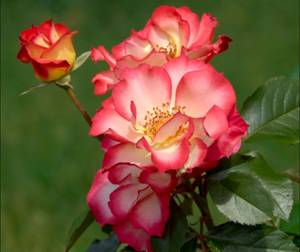
Floribunda rose
Big trees, if space permits, can go in the backyard but should not be overcrowded in the front. But a few low-growing trees can be accommodated at the appropriate places as next to entrance, if space is available or somewhere in the front lawn. An open spacious lawn with some annuals (cut-and-come again zinnias, salvias, and petunias) or herbaceous perennials (chrysanthemum, Canna, and Impatiens in shade) can be planned in addition to the foundation plantings.
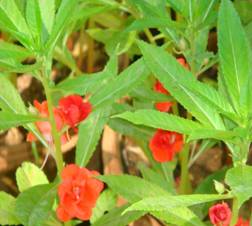 . . 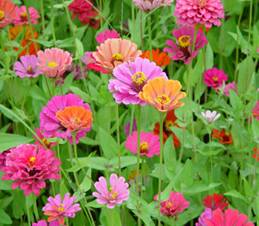
Impatiens balsamina Zinnia
(2) Work or Service Area: The work or service area can be convenient, orderly and attractive. Wherever feasible this and the living area should be situated at the back of the house as these need seclusion or privacy. This area includes the kitchen garden, compost bin, nursery, tool shed, and garage. Some people like to include the children's swings and the slide in this portion as the children can be kept under surveillance from the kitchen. This should be separated from view by planting a thick hedge or a row of bushy shrubs, as this is considered as the shabbiest part in any garden.
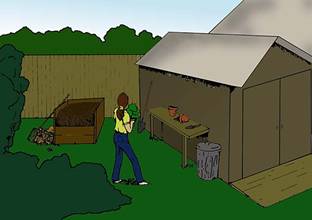
Service area
(3) Private Garden Area or Living Area: This is generally termed as the outdoor living area, where people sit out in the winter to enjoy the sun or rest in the summer under an arbour or shade of tree. This area should be easily approachable and visible from the living (drawing-room) or dining-room, screened from unsightly objects and for privacy. In the western countries people prefer a terrace and this is the place where it should come. There should be some shaded sitting spot such as a tree or arbour with garden benches.
Landscaping can help you effectively cover your outdoors thereby helping you block unpleasant views from outsiders or your own neighbors. Building huge walls to achieve this would be undesirable when the same can be achieved beautifully through landscaping.
Garden benches offer a real opportunity to add utility, color and beauty to the landscape. Comfortable and attractive items are now available in a wide variety of low maintenance outdoor furniture. Outdoor furniture must be large enough to be practical and must be in scale with its surroundings. Built-in furniture has the added value of being permanently in place and enhancing the overall design. Occasionally the surface of a retaining wall or raised planter can serve as a seating area. The living terrace is the most usual place for outdoor furniture.
A wide stretch of lawn with shrub border or few annual beds or a rose garden can also be included in this section. A tennis court or a play area has to be included here, if there is enough room.
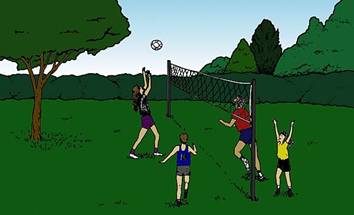
Play area
But before actual planning one has to first decide what one wants for one's house. A choice has to be made from the following. Whether the garden is needed (a) as an outdoor having room with a long stretch of lawn and terrace (b) as a fenced-in playground (c) as a show piece with collection of exotic and rare plants or (d) a yielder of vegetables and fruits or cut flowers for the house is to be determined first. Some may like to add to the list a large tree for shade or trees to attract birds. It is to be considered first what should be the major theme of the garden.
If somebody is fascinated with flowers, the borders are to be planned wide to fulfill his desire. People fond of vegetables and fruit may like to reserve the major portion of the area for this purpose with possibly a little area left around the house for a pleasure garden. But, if the garden is desired as a place for outdoor living, a vast expanse of lawn with minimum of beds and borders has to be planned. Some novices may like to combine the good qualities of all these themes and incorporate in his garden. This is bound to create a mess of everything and the ultimate result will be a garden good for nothing.
Many people advise not to include any pool or formal rock garden or the kind in a home garden. But there is no harm if a formal or informal 1i1y pool can fit in with the overall design, with or without a fountain or a rock garden. A statue or sun dial can also be well fitted in some spacious compounds.
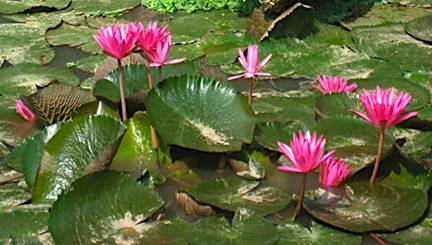
Lily pool
Some Points to Ponder
In designing a house some more thinking is necessary. To keep down maintenance cost and time, an untrimmed hedge should be preferred over trimmed one, open lawns and shrubs need less attention than annual flower beds. If the beds and borders in a lawn are edged with stone or brick no hand-clipping of grass will be required. A pool needs to be cleaned occasionally and one should ponder twice before including this in the plan. The water outlets in the garden should be fixed at appropriate places so that the hoses are not dragged to long distances. The above suggestions are for reducing the labour cost which is especially relevant in industrially advanced countries where labour is costly. Fortunately in India, labour is not so costly' and one can include one or two features needing help of manual labour.
To create privacy, trees, hedges, shrubs, fences, or creepers trained on wire-mesh structure supported by angle iron or G.I. pipe pillars can be grown. Trees are used when height is needed, otherwise hedges and other types of screens should be preferred.
Lighting is needed in the light special1y for terrace area and paths. The same electricity points can be utilized for running an electric lawn mower.
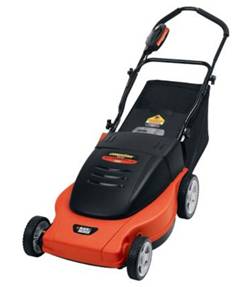
Electric lawn mower
How to Proceed
When everything has been decided, it is time to tentatively select the plants needed. The different features are then drawn on the paper with a pencil so that this can be erased if alterations are to be made. After thorough study and several additions and omissions a plan is finalized. For an experienced man, this would not be much of a problem. But a novice must visit the neighbours and see some of the local parks to know what can be grown. The first thing is to select the materials for the basic framework such as background, screens, trees needed for shade, the doorway and the corner of the house. To this the features needed for effects and beauty as for example plants for foundation planting, flower beds, specimen shrubs or trees are added.
After everything is finalized on paper these are put into practice on the ground with the help of split-bamboo stakes and rubber hose. The trees are represented by bamboo stakes, while the beds and borders can be plotted by bending a rubber hose in the desired pattern, Paths, hedge, or screen area can also be marked with stakes. When everything is plotted the design is studied again and last-minute changes are effected if required. After this, digging and planting work are started according to plan. Before implementing the plan some compounds may need a little dressing-up like cleaning, levelling and tidying-up.
Salvaging an Old Garden
If a property has been purchased which already had some garden, it is to be studied whether the old garden can be re-made. This is a complicated job which has its advantages and disadvantages. It is often difficult to adjust some existing features into the new plan. The aim is to incorporate in the new design every interesting existing feature and remove others not needed. A bird bath, water garden and terraces should be retained and improved upon. The remaking process has to be completed slowly after watching every feature carefully and evaluating their utility in the new design.
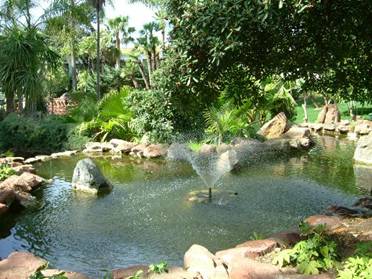
Water garden
Problems and solutions
Often it so happens that a double-storey house has a one-storey garage attached at one side of the building thus disturbing the whole balance. The solution in correcting this imbalance lies in planting tall trees with rounded canopy along the garage end. It is also important to select the proper plants near the house to soften and broaden the view of the house. A medium tree with low-branching habit and with a rounded or little oval-shaped top is planted near the corner with some low-growing shrubs planted around it. Trees such as silver oak, Amherstia nobilis, Cassia nodosa, Dillenia indica, Gulmohar, Magnolia grandiflora and Saraca indica can be used for this purpose. If the tree selected is deciduous in nature the evergreen shrubs below should form the contrast. For a two-storey house, a high branching rounded canopy tree such as Anthocephalus cadamba, Erythropsis colorata, Michelia champaca, and Polyalthia.longifolia should be planted farthest from the corner of the house and in between a fairly large second tree or shrub is planted, besides some other low-growing shrubs.
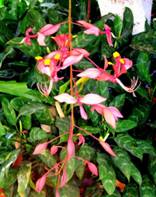  
Amherstia nobilis Gulmohar Michelia champaca
A doorway near the house needs special attention as this is the place which receives maximum attention from a visitor. Depending upon the approach a doorway can be planted informally, formally, or in a semi-informal pattern. It can be arranged with a garden-type design consisting of an ornamental shade or flowering tree perennial and annual flowers, climbing roses, some bulbs such as Zephyranthes, Amaryllis and daffodils (for temperate regions). Where it is not possible to plant the annual and perennial flowers in ground these can be put in tubs and arranged artistically. An ornamental light post, an urn or an artistically shaped boulder will be an object of interest when placed near the shade tree or in an appropriate corner. A bed of roses can also be a spot of beauty provided it receives the morning sun. Symmetrical plants with pyramidal form such as Thuja, Juniperus chinensis, and Cupressus macrocarpa are preferred by many near the doorway for a formal treatment.
 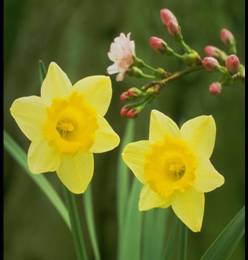
Amaryllis Daffodils
If a plot is rectangular in shape, where the length is far greater than the breadth, the best way to develop such plot will be to divide the whole area into a series of garden compartments enclosed by hedges with continuous walk of gravel paving or grass connecting each segment with the other. But some people may prefer to have long stretches of open lawn, when this arrangement will not do. In such cases the plot should at least be subdivided into two segments as too much of a rectangular land with narrow width is not pleasing to the eye.
Many people inherit irregular-shaped plots specially those who are allotted the corner plots. It is far more difficult to plan a garden for such plots compared to a rectangular or a square plot. Inept handling may ruin such plots but a man with imagination and artistic sense can develop a garden which will be far more interesting than a garden in a regular shaped plot. Such plots should receive informal treatments. An irregular-shaped corner may be tackled by constructing an informal lily pool. Similarly beds and borders should be shaped irregularly according to the contour of the plot. It may be far more convenient to develop a rock garden in a shapeless corner than to have a lawn or flower bed. It may be wise not to have formal paths of any kind; instead, the various areas may be reached by stepping-stones placed in artistically-curved fashion over the grass. These are only a few suggestions. Much depends on the imagination and tact of the man doing the job on the spot as the situation demands.
Plans for very small compounds
What we have so far discussed suits the plots which are relatively large. For very small plots which cannot be divided into different segments such as public area, living area, and work area, one has to depend upon one's own imagination to landscape such plots. But it should be remembered that the majority of the flowering plants and Calcutta doob do not flourish well in a shaded place. For such plots situated under shade it is wise to put shade loving foliage plants and flowering plants preferring semi-shade such as Impatiens sultanii, geranium, day lily and footfall lily. Otherwise, a lawn planted with a few specimen shrubs or roses or one or two small beds of flowering annuals will be more than sufficient for small compounds situated in the open. In all probability it will not be possible to have any large tree in such compounds.
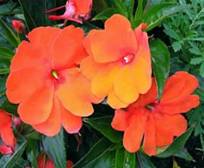 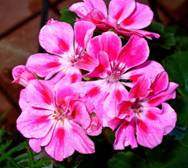
Impatiens sultanii Geranium
What we have discussed so far are some possibilities and nothing is sacrosanct. One can use one's own imagination to alter one plan or other. Actually landscape design has a wide flexibility and the same plot can be landscaped in two or more different ways. Moreover, opinion varies between one landscape designers to another and hence, the controversy whether a design is perfect will never end. But the basic theories must be followed and mistakes such as overcrowding, monotony and placing of plants in wrong situations (e.g., a sun-loving plant placed under the shade of a tree) should be avoided. Once the design is decided, the different features such as paths, walls, pools, lawn are constructed as per the procedures suggested in this book. The basic necessities such as irrigation and drainage should also be taken care of.
Trees suitable for small gardens
While selecting trees for the home garden the following questions must be answered. First of all, why the tree is needed? Is it for a background or corner planting to frame the house; whether this is needed for shade for sitting or for the terrace and if so, whether grass will grow under shade? Once the questions are answered, the right type of tree has to be selected. Enough room has to be left for the tree to grow. As for example, a 25 x 50 m plot has room only for a large shade tree and two to three small flowering trees. Shallow rooted trees such as Millingtonia hortensis should not be planted as they are surface feeders and may be uprooted by storms.
Some trees suitable for the garden have already been mentioned in the course of discussion, but some more may be added. Bauhinias in different species are quite suitable.

Bauhinia purpurea
Bottle brush is suitable for many situations. Tecoma argentea is a wonderful flowering tree for home gardens around Bangalore. The following trees are also suitable for planting in the home grounds: Mimusops elengi, Gliricidia maculata, Cochlospermum gossypium, Cassia fistula, and Cassia spectabilis.
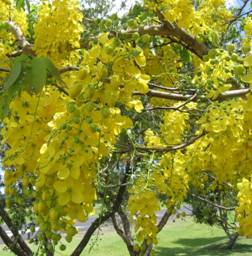 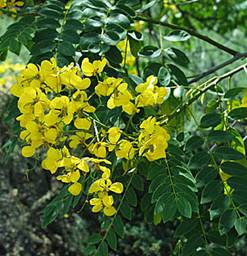
Cassia fistula Cassia spectabilis
Some shrubs may be grown as specimens in the lawn. A few suggested shrubs are Ixora singaporensis, Brya ebenus, Sophora tomentosa, Mussaenda philippica, Azalea, Cotoneaster horizontalis and Rhododendrons in different species. The last three are suitable for temperate climates. For shrubbery border a list of shrubs may be made from the chapter on ornamental and flowering shrubs, depending upon situation.
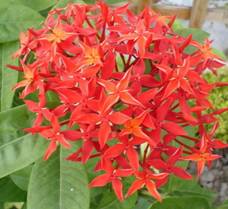 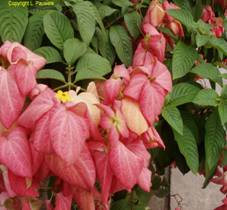
Ixora singaporensis Mussaenda philippica
Landscaping a Country Home
A villager in India may not need a sophisticated garden as has been discussed in the foregoing pages. However, a countryman will need as much privacy as a city dweller. A village home has to be planned with more utility items. A villager would like to grow more vegetables and fruit for his family consumption and consequently more area should be earmarked for this purpose. But a shade tree or two and some area reserved for children's playground is definitely needed. Some utility flowering trees such as Michelia champaca, Plumeria acutifolia and shrubs such as Hibiscus rosa-sinensis, Tabernaemontana coronaria, Barleria, and Jasmines yielding flowers for worshipping and hair decoration should be included for planting.
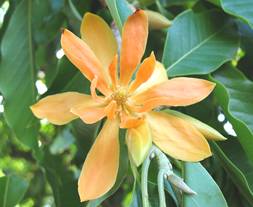 
Michelia champaca Hibiscus rosa-sinensis
 
Tabernaemontana coronaria Barleria cristata
The common flowering annuals such as marigold, zinnia, balsam, and sunflower can be grown for beauty and cut flowers for various purposes.
Top
2. LANDSCAPING OF INSTITUTE
A planned and properly landscaped school building will be different in appearance and beauty than unplanned one. Moreover a good garden in the campus inculcated aesthetic sense to our younger generation.
The general recommendations is to plant large trees in the school compound in the periphery of the school campus, along the rear and wings, a thick belt of large shady trees should be planted to bring down noise and cut down dust and storms. This plantation will also help keep down severe heat and cold. The front should be planted with medium-sized flowering trees for beauty. The trees should not completely obstruct the view of the building from outside. For enhancing the scenic beauty it is also suggested to plant a row of flowering trees, with different blooming seasons, in front of the large trees along the periphery. It is difficult to give any general recommendation regarding the types of such trees, as this will vary according to the architectural design, situation and climate. The object is to provide beauty and comfort depending on convenience.
The roads and paths are to be formally planted with medium to tall flowering plants. Before planting provision should be made for overhead wiring and sewerage so that these do not interface with the avenue planting. Where the electric wires limit the choice of avenue trees, small flowering trees such as Cochlospermum gossypium, Callistemon lanceolatus, Bauhinia variegata, and Tecoma argentea can be planted. The trees should be planted in pure avenues. A lawn looks nice in an educational institution, but is very difficult to maintain. The playground can be planted with lawn, if this can be maintained or should be left bare.
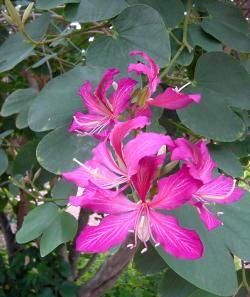 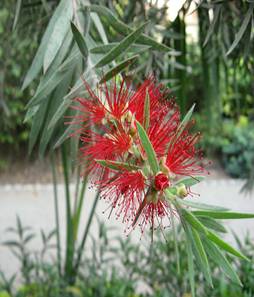
Bauhinia variegata Callistemon lanceolatus
A thickly planted belt of eucalyptus for peripheral planting is considered ideal. Silver oak, Polyalthia and Samanea saman are also suitable for this purpose. Cassia fistula, Tecoma argentea, Erythrina indica, Lagerstroemia flos-reginae and Bauhinia variegata are suitable for planting in the front and in the front row of the border planting.
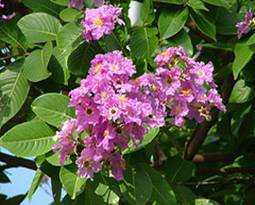 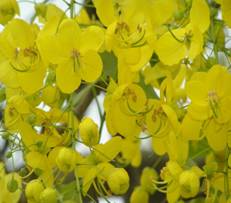
Lagerstroemia flos-reginae Cassia fistula
The roads and paths are to be formally planted with medium to tall flowering plants. Before planting provision should be make for overhead wiring and sewage so that these do not interfere with the avenue planting. Shrubs play an important part in the school landscaping. Shrub borders round parks or playgrounds is very effective and can replace hedges as the maintenance is minimum. A lawn look nice in an educational institution but it is very difficult to maintain. A bougainvillea creeper trained over the wall of the building can change the whole look. Similarly, a Bignonia venusta supported against a wall also looks beautiful. A creeper climbing with their rootlets such as Ficus repens, Tecoma radicans can also be trained over some stone or brick wall.
Besides an ornamental or a landscape garden, universities and colleges can also maintain a botanical garden or a student garden, where the plants are arranged in groups, family wise so that such gardens become educative.
Top
3. LANDSCAPING OF INDUSTRY
In modern times, a factory should not become a place of only machinery, dust, pollution and noise, but should also be provided with nicely laid-out parks and gardens. This is not only needed from the point of beautification, but also to fight pollution and dust. The factories may be broadly categorized into two groups. The first group comprises comparatively neat factories such as a plywood factory or a fruit processing plant which emit less dust and other polluting materials. The second group consists of factories such as cement, steel, fertilizer, etc. which emit a lot of dust, smoke, and harmful chemicals. The primary aim in a factory garden will be to plant trees to arrest the drifting dust and smoke and to cut down noise.
Another important aim is to provide ample shade and coolness so that the workers get a respite under the coolness of trees from the hostile hot interior of the factory. Moreover the trees bend down the temperature in the factory premises to a considerable extent. The places where garden can be laid in the factory area are canteen, rest-shed, hospital, administrative building etc.
It is interesting to note that well landscaped offices tend to have lower cases of absenteeism and job shifting. It has also been found that employees serving in offices featuring colorful landscaped entrances show better productivity. The reason for this can be attributed to the basic fact that humans have a fundamental desire to keep contact with nature. Our perception and moods are highly influenced by the colors we see in and around us
Tall and hardy trees such as Casurarina equisetifloia, Eucalyptus, Polyalthia logifolia and Silver oak should be planted all around or in the direction of the winds to stop the spread rows of plants planted in a staggering manner bring down the noise from the factory to the surroundings outside this barrier.

Polyalthia logifolia
Moreover, in a well-planted factory, the trees bring down the zone may be created by afforestation between the factory and its residential colony. Afforestation can be done with hardy ornamentals such as Acacia auriculiformis, Casuarina equisetifolia, Dalbergia sisso, and some other shade trees. Besides planting of trees, a factory area can also be beautified with rockeries, statues water pools or lakes, fountains, etc. Bougainvillea should be used freely to beautify a factory area.
Root zone process is a German Technology to treat industrial and domestic waste water economically, efficiently and naturally. Three integrated compounds are essential to this system. They are the reeds, the reed bed and the microbial organisms.
Run the contaminated water under the root zone and the reed beds treat the water. The out coming water is clear, odourless and free from contamination which can be used for gardening and farming.
Landscaping can hugely enhance the sales appeal of a property thereby increasing the overall property value. The factors that seem to contribute in increasing the property values include greenery, walkways, arches, patios, decks and ponds.
Thus there is vast scope for the development of industrial and institutional landscapes. Such landscapes should aim to improve the aesthetic beauty of the place and reduce the pollution.
Top
4. ROOF GARDENING
Garden is an embellished area with plants. The importance of gardening has been well understood by every individual. The gardens not only serve as a place of recreation, it also serves as a place for education by the way of establishing a home garden or botanical gardens.
The art of creating the greenery and maintaining the greenery is known as “Roof Gardening”. This is also known as Terrace gardening. The existing roof top can be effectively utilized for growing fruit plants, vegetables, spices, homestead medicinal plants, flower plants and ornamental plants. The population explosion occurs every day resulted in the migration of peoples from rural areas to urban areas for income generation. Due to migration of peoples most of the agriculture lands are converted into residential areas, resulted with decreased production of fruits and vegetables. This can be circumvented by kitchen gardening and roof gardening.
In urban areas, due to escalating population, more land area is brought under the construction of houses; therefore there is hardly any space for growing vegetables. Especially in multistoried buildings, roof gardening is the only way to grow fruits and vegetables by using the pots and containers. This practice is known as container gardening. Psychiatrist recommends that working in garden refresh the body and mind by reliving harsh stresses. Gardens become the integral part of the family life benefited by the supply of toxic free fresh fruits and vegetables.
Dietitians recommend 85 grams of fruits/day, 300 grams of vegetables/day, whereas the present day consumption of fruit is only 30 grams/day and vegetables is 120 grams/day. The consequences of nutritional and vitamin deficiency are given as follows.
Nutrients |
Consequences of deficiency |
Calories and proteins |
Retarded growth in children; irritability, apathy and retarded mental development; discolouration of skin and hair; swelling of face and lower part of the legs and feet, fatty liver, and extreme emaciation. |
Vitamin A |
Inability to see in brightness, sensitivity to night light, foamy white patches on the conjunctive softening of the cornea, leading to blindness; frequent respiratory infections. |
Vitamin B
Thiamine (B1) |
Causes beriberi; loss of appetite. |
Riboflavin (B2) |
Cracks at the corners of the mouth; cracked lips; glossy tongue; ulcers in the oral cavity. |
Nicotinic acid |
Sore tongue (scarlet coloured); pellagra, showing skin changes on hands, feet, legs and neck; mental changes in severe condition. |
Vitamin C |
Scurvy – bleeding gums and mucus membranes and susceptibility to infection as common cold. |
Calcium |
Important for bones and teeth, blood clotting. Osteomalacia in women after repeated pregnancies. |
Iron |
Anemia – pale smooth tongue, pale eyes and skin; spoon – shaped nails; frequent exhaustion. |
Aims of roof gardening
Location of garden
- Roof top/ verandah / window sills
- Preferably open areas with plenty of sunlight and water supply
Roof gardening can be established in a best manner with the availability of sun light and water. Plants produce quality fruits and vegetables by using sunlight and water. Since there is not enough place in the flats these days, this garden can be laid on roof tops, there by effectively utilizing the available space on the roof tops. In multistoried buildings, not all the apartments have a roof. Thus the pots can be placed in the verandah and window sills.
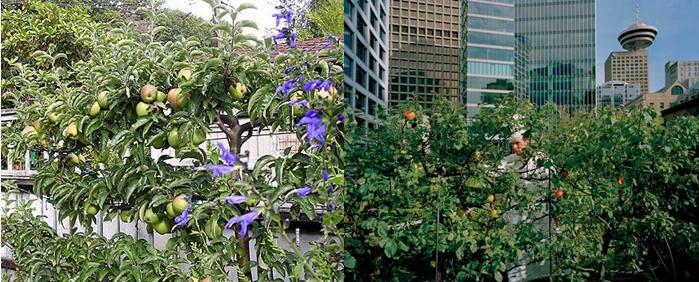
Fruit crops in roof garden

Vegetable crops in roof garden
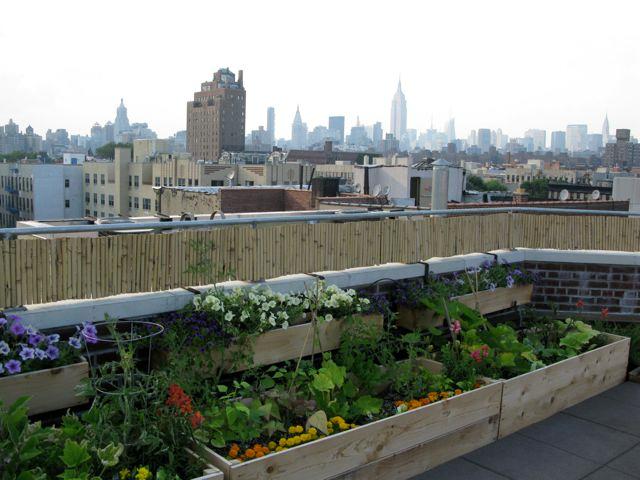
Flower crops in roof garden
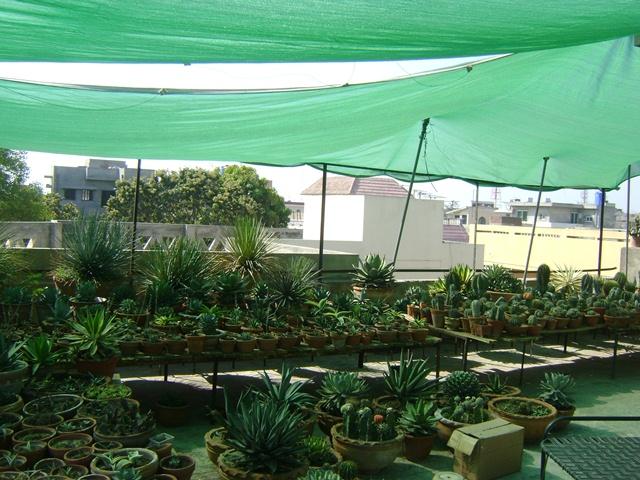
Cacti and succulents in roof garden
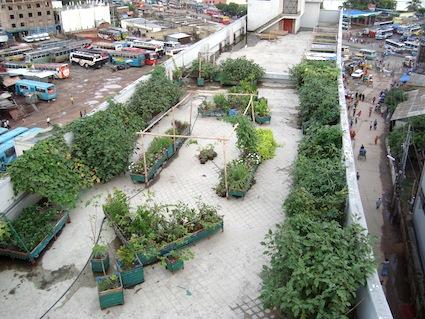
Medicinal plants in roof garden
Method of cultivation in roof top
1. Trough / Benches
In the open roof top, based on the bearing load, cement benches of convenient length and depth can be constructed and the soil mixture (2 parts of red soil + 1 part of sand + 1 part of compost) filled up and utilized for growing the fruit or vegetable crops. Leave 1” space at the rim, to facilitate irrigation.
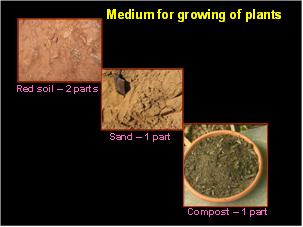
2. Trough (For newly build houses)
For efficient utilization of roof spaces, an inward trough is formed in the unutilized spaces of roof top i.e., like sunkened trough. The length and depth of trough may be designed as per the requirement. The available area is properly coated with water-proofing materials to avoid the seepage of water into the roof area. The inner side is designed with a gradual slope to facilitate the drainage. The drainage hole is covered with wire mesh and gravel for ensured drainage. Finally the entire area is laid with geo-textile material and finally filled up with the soil mixture for raising fruits and vegetable.
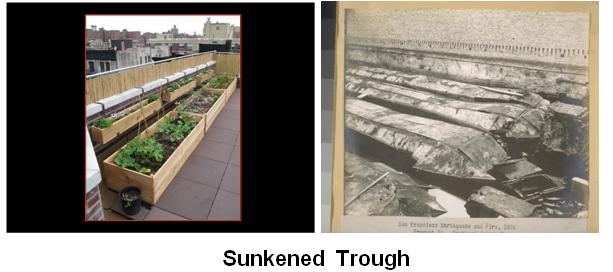

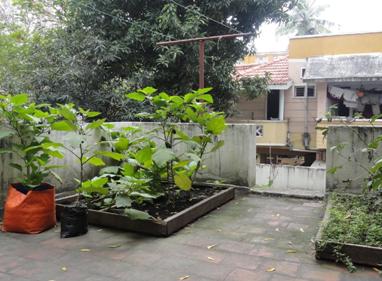
Bearing of Brinjal
3. Pots / Containers :Pots and Containers can be used for raising the fruits and vegetables.
Types of containers
- Cement pots
- Earthen pots
- Plastic barrels
- Wooden barrels
- Boxes
- Crates
- Paws
- Plastic jars
- Damaged buckets
- Tin boxes
- Drums and different sizes
- Plastic covers
- Cement / Fertilizer bags
- Damaged sink / wash basin
- Damaged bowls / water tanks
- Unused water cans
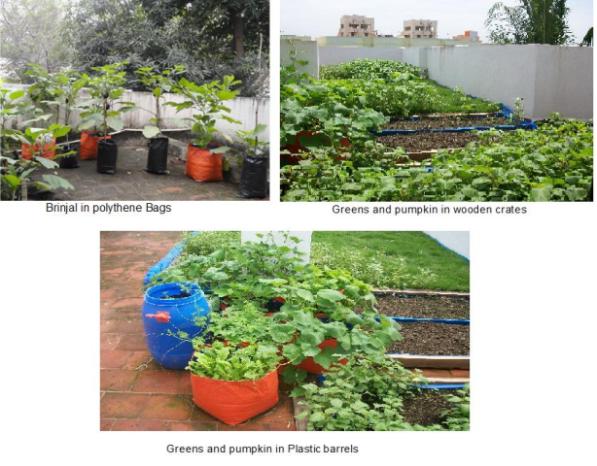
Seed pan and seed boxes
Seed pans are shallow earthen pots about 10cm high and 35cm in diameter with a drainage hole at the bottom. Seed boxes are made of wood, porcelain and earthen pots of 40cm wide and 60cm long and 10cm deep, with 6-8 properly spaced holes drilled in the bottom. Against each holes a crock is placed with its concave side down. Some large pieces of crock are put over it and also by the side of this crock, some coarse sand 2 or 3 handfull is sprinkled on the crock pieces forming a thin layer to prevent fine soil from clogging the drainage hole. Over this, required soil mixture is added and kept in open sunlight for raising the vegetables.
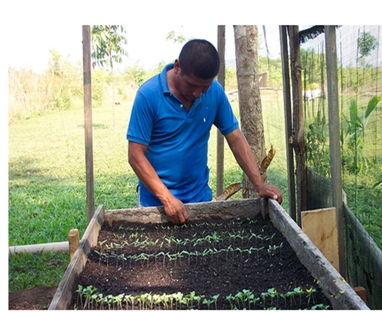
Earthen pots
Earthen pots made of burnt porous clay in various sizes to hold enough quantity of soil and roof space for cultivating different kinds of plants. They have straight sides and are made wider at the top than at the bottom to hold the greatest bulk of compost and also to facilitate easy removal of soil, intact with roots (ball of earth) at the time of planting or repotting.
In our country, pots of varying sizes viz., tube pots, ¼ size, ½ size, ¾ size and ‘thali’ are used commonly. Tube pots are used to raise the rootstocks of mango and sapota for grafting purposes. ¼ size pots are used for potting singly very small seedlings during first transplanting and also for layering in plants like West Indian Cherry and Guava. ½ size pots are extensively employed for growing well rooted cuttings of several kinds of plants and small plants of all kinds. ¾ size pots are preferred for growing Dahlia, Cannas, Palms, Shrubs, Roses etc. In addition to the above, the earthen pots were filled with soil mixture and used for raising vegetable crops. Apart from the above, the soil mixture is filled in polythene covers and used for the cultivation of vegetables like tomato, brinjal, chilli, turmeric, coriander, amaranthus etc.,

Polythene bags
Small polythene bags with punched holes at the bottom for drainage and filled with a porous rooting medium are used for propagation of cuttings like jasmine, duranta, crotons etc., in the mist chamber. Some times, young seedlings which are raised in the nursery are subsequently transplanted in these polythene bags are kept there till they attain required growth for transplanting them to the main field (e.g., papaya, curry leaf etc).
Plastic pots:
Plastic pots, round and square are used to keep mostly indoor plants. They are reusable, light weight, non-porous and they require only little storage space.
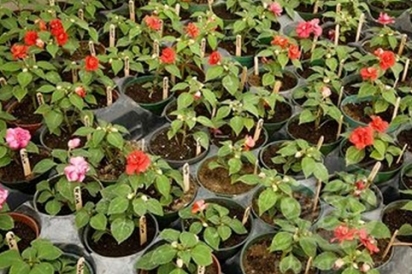
Fibre pots:
These are available in small size varying from 5-10 cm width and are either round or square in shape. They are bio non-degradable and last longer periods with the soil and plants inside.
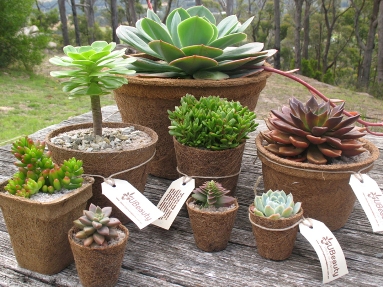
Paraffined paper or Styrofoam cups
They look like ice-cream cups with drainage holes. They serve satisfactory as temporary containers for growing and transferring young plants on a large seed bed. They are light, cheap and require little space. Recently, thermocole molded pots have been gaining popularity as they are light weight and attractive.
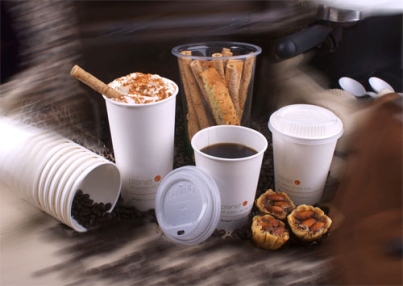
Tools
- Hand hoe
- Spade / showel
- Rose can
- Hand sprayer
- Gardening hose with sprinkler
- Bamboo stakes and jute strings
Other inputs
- Quality seeds from reliable sources like Agricultural University and Research Stations and National Seed Corporation.
- Good soil free from stones, weeds and other undecomposable materials
- Well decomposed organic manure (compost / FYM / leaf compost / digested coir compost)
- River bed sand
- Chemical fertilizers
- Insecticides
- Fungicide
- Organic inputs (Neem oil, Neem seed kernel extract, Panchakavya)
How to start
- Wash the container thoroughly and make drainage holes at the bottom
- Mix soil, compost and sand with the help of hand hoe and shovel.
- Fill the containers loosely with a gentle tap. The soil should settle, bearing one inch head space at the top for irrigation.
- a). For the transplanted vegetables, where nursery has to be raised, shallow pans and troughs can be filled with the fine mixture of soil, sand and compost (1:1:1) and the seeds should be sown. The container should be irrigated immediately after sowing. A layer of dry grass or straw is spread on top of the soil till the seedlings emerge, and thereafter it is removed. Most of the seedlings are ready for transplanting with one month of sowing. Recently, protrays are employed for raising vegetable seedlings. Protrays are the plug trays of 2-3’’ depth with a drainage hole. Initially ¼ portion of plug are filled with compost and one seed is sown in each plug and cover the remaining portion with compost or sand mixed compost. The watering and other operations are similarly to the above method.
b)The seeds of certain vegetable crops which can be sown directly, should be sown in the selected pots/ polythene bags etc., The depth of the seed sowing should be about two and a half times of the seed size. Most of the vegetables are raised by sowing their seeds directly in containers. The seedlings of brinjal, chilli, tomato, capsicum and onion are transplanted in containers / pots after 30-40 days of germination. Their seedlings can also be raised in earthen pot or pans. A single healthy seedling may be transplanted in each container. Several seedlings, each of onion and knolkhol, and can be transplanted in a container of the same size. Two or three seeds are sown directly in such containers and later thinned out retaining healthy seedlings. The number of plants per pot may be varied with shape and size.
Crop selection and raising
Sl.No. |
Vegetables |
Sowing / planting |
Days to First harvest after sowing / planting |
Method |
Time |
1. |
Amaranthus |
Sowing |
February- March
July- August |
25-30 |
2. |
Beet root |
Sowing |
October – December |
90-100 |
3. |
Bittergourd |
Sowing |
February-March |
55-60 |
4. |
Brinjal |
Transplanting |
January - February
July – August |
45-60 |
5. |
Broad bean |
Sowing |
September – October |
70-75 |
6. |
Chilli |
Transplanting |
January - February
July – August |
50-60 |
7. |
Cluster bean |
Sowing |
July – August |
30-35 |
8. |
Cowpea |
Sowing |
January - February |
60-65 |
9. |
Cucumber |
Sowing |
February- March |
45-50 |
10. |
Methi/ Fenugreek |
Sowing |
September – December |
45-50 |
11. |
Mint |
Transplanting |
Match – July |
45-50 |
12. |
Okra / Bhendi |
Sowing |
June – July |
30-35 |
13. |
Onion |
Transplanting |
June-July
October - November |
75-80 |
14. |
Radish |
Sowing |
Round the year |
25-30 |
15. |
Spinach |
Sowing |
September – October |
50-55 |
16. |
Tomato |
Transplanting |
December - January
June – July |
60-65 |
20. |
Turnip |
Sowing |
September-October |
40-45 |
Cropping pattern
Generally almost all vegetable and spice crops are raised in three seasons Vaikaasi pattam, Adi pattam and Thai pattam. For small scale purpose i.e., cultivation in home stead gardens, we need not depend on any season; but raising of vegetables can be avoided during summer seasons.
Plots |
May-June to
September-October |
September – October to December-January |
December-January to May-June |
Annual crops |
(a) Bitter gourd |
Lab lab |
Snake gourd |
(b) Brinjal and chilli |
Amaranthus |
Okra |
(c) Ash gourd |
Pumpkin |
Amaranth |
(d) Bushy / semi-trailing cowpea |
Tomato |
Cucumber |
(e) Okra |
Ash gourd |
Chilli / brinjal |
(f) Pumpkin |
Okra |
Onion |
Perennial crops |
(a) Vegetables |
Drumstick, curly leaf, Chekurmanis, culinary banana, Chekkurmanis, Agathi |
(b) Fruits |
Banana, acid lime, papaya, West Indian cherry, guava, rose apple etc. |
(c) Spices |
Ginger, turmeric, mango ginger |
Fruits crops suited for roof garden
- Banana, Guava, Acid lime and Papaya
Vegetable crops suited for roof garden
- Transplanted vegetables: Tomato, Brinjal, Chilli
- Direct sown vegetables: Bhendi, Amaranthus, Cucurbitaceous vegetables like – Bitter gourd, Snake gourd, Ridge gourd and Bottle gourd, Radish and Beet root
Spice crops suited for roof garden
- Turmeric, Coriander and Fenugreek
Medicinal crops suited for roof garden: Agathi, Adathoda, Aloe vera, Oomathai, Lemon grass, Oomavalli, Karisalanganni, Perandai, Keelanelli, Thuthuvelai, Ponnanganni and Manathakali
Cultivation of fruits
| S.No. |
Crop |
Varieties |
Plating materials |
Spacing
(m) |
Yield
(Yield varies with varieties and spacing adopted) |
| 1. |
Mango |
Neelum
Banganapalli
Mallika
Bangalora, Alphonso, Rumani, |
Grafts |
5 m x 5m |
8 – 10 t/ha upto 15 years
15 – 20 t/ha from 15 – 20 years |
| 2. |
Banana |
Robusta,
Dwarf Cavendish, Grand Naine, Rasthali,
Poovan, Nendran, Karpooravalli, |
Suckers |
2 m x 2 m |
Yield (t/ha/year)
Poovan: 40 – 50
Monthan : 30 – 40
Rasthali : 40 – 50
Robusta : 50 – 60
Dwarf Cavendish : 50 – 60 |
| 3. |
Guava |
Allahabad, Lucknow 46, 49, Arka Amulya, Arka Mridula, Banaras, Baptla |
Layers |
5 m x 5m |
25 t/ha |
| 4. |
Sapota |
Oval,
Cricket Ball,
Kirtibarti,
Guthi,
CO 1,
CO 2,
CO.3,
PKM 1,
PKM 2,
PKM 3,
PKM-4,
PKM (sa)-5 and Kalipatti |
Grafts |
8 x 4 m |
20 - 25 t/ha/year |
| 5. |
Papaya |
CO 1,
CO 2,
CO 3,
CO 4,
CO 5,
CO 6,
CO 7,
Coorg Honey dew and
Surya |
Seeds |
1.8 m x 1.8 m |
CO 2 : 600 kg/ha
CO 5 : 800 Kg/ha |
6. |
Acid lime |
Local varieties, PKM1 |
Budded plants |
4 m x 4 m |
25 t/ha/year |
Cultivation of vegetables
S.No. |
Crop |
Varieties |
Plating materials |
Spacing
(m) |
Yield
(Yield varies with varieties and spacing adopted) |
1. |
Tomato |
PKM 1,
CO 3 (Marutham) and Paiyur 1 |
Seed |
PKM 1, Paiyur 1 :
60 x 45 cm
CO 3 : 45 x 30 cm |
PKM 1 : 30-35 t/ha
CO 3 : 40 t/ha
Paiyur : 30 t/ha |
2. |
Brinjal |
Co 1,
Co 2,
MDU 1,
PKM 1,
PLR 1,
KKM 1,
PPI 1,
Annamalai and COBH 1 (Hybrid) |
Seed |
60 x 60 cm,
For hybrids 75 x 60 (or) 75 x 75 cm |
Varieties : 25 to 30 t/ha
Hybrids : 45-50 t/ha |
3. |
Chillies |
K 1,
K 2,
CO 1,
CO 2,
CO 3,
CO 4 (Vegetable type),
PKM 1,
KKM 1,
KKM (ch) 1,
PLR 1 |
Seed |
45 cm x 30 cm |
2 - 3 t/ha of dry pods
10 - 15 t/ha of green chilli |
4. |
Snake gourd |
CO 1,
CO 2,
PKM 1,
MDU 1 and
PLR (SG) 1 |
Seed |
2.5 m x 2 m |
18 t/ha |
5. |
Ribbed gourd |
CO 1,
CO 2,
PKM 1,
Arka Sumeet and Arka Sujath |
Seed |
2.5 m x 2 m |
14 – 15 t/ha |
6. |
Bitter gourd |
CO 1,
MDU 1,
COBgoH 1 (Hybrid), Arka Harit,
Priya and
Preethi |
Seed |
2 m x 1.5 m |
Varieties: 14 t/ha
Hybrids : 40 t/ha |
7. |
Cluster beans |
Pusa Mausami, Pusa Naubahar, Goma Manjari and Pusa Sadabahar |
Seed |
45 cm x 15 cm |
5 – 7 t pods/ha |
8. |
Vegetable Cow Pea |
CO 2,
VBN 2,
Pusa Komal and Arka Garima |
Seed |
45 cm x 15 cm |
5000 kg/ha |
9. |
Annual Moringa |
PKM 1, PKM 2 and KKM 1 |
Seed |
2.5 m x 2.5 m |
50 - 55 tonnes of pods/ha
(220 pods/tree/year) |
10. |
Radish |
CO 1,
Pusa Rashmi,
Pusa Chetki,
Pusa Desi, Japanese White and Arka Nishant |
Seed |
15 cm x 10 cm |
20 – 30 t/ha |
11. |
Small Onion/ Aggregatum |
CO 1,
CO 2,
CO 3,
CO 4,
MDU 1 and
Co (On) 5 (free flowering and seed setting type) |
Seed / Bulb |
15 cm x 10 cm |
12 – 16 t/ha
For Co (On) 5 onion, 18 t/ha in 90 days |
12. |
Amaranthus |
CO 1 (Mulaikeerai and Thandukeerai)
CO 2 (Mulaikeerai and Thandukeerai)
CO 3 (Clipping)
CO 4 (Grain)
CO 5 (Mulaikeerai and Thandukeerai) |
Seed |
15 cm x 10 cm |
Leafy types
25 days after sowing for Mulaikeerai (10 t/ha)
40 days after sowing for Thandukeerai (16 t/ha)
Clipping types
10 clippings at weekly intervals
(30 t/ha) |
13. |
Curry leaf |
Sen Kaampa, Dharwad-1 and Dharwad-2 |
Seeds / Suckers |
1.5 m x 1.5 m |
250-400 kg of leaves/ha |
Cultivation of Spices
S.No. |
Crop |
Varieties |
Plating materials |
Spacing
(m) |
Yield
(Yield varies with varieties and spacing adopted) |
1. |
Turmeric |
CO 1,
BSR 1,
BSR 2,
Local cultivar: Salem and Erode |
Rhizome |
45 cm x 15 cm |
Fresh rhizomes : 25-30 t/ha |
2. |
Coriander |
CO 1, CO 2, CO 3 and CO (CR) 4 |
Seeds |
15 cm x 10 cm |
Leaf yield : 6-7 t/ha |
3. |
Fenugreek |
CO 1, Pusa early bunching and CO 2 |
Seeds |
15 cm x 10 cm |
Yield of green : 4000 - 5000 kg/ha |
Cultural practices
Watering
Plants in pots and containers need a lot of care and attention. It is essential to water the plants judiciously depending upon the season, kind of crop, size of the plant and size of the container. Plants need extra water during summer season and hence the plants should preferably be irrigated twice a day. Too much watering will also lead to problems; hence we should strike a intelligent balance. The thumb rule for irrigation is that the top soil should be scratch about one inch and seen, if the lower soil is damp, there is no need of immediate irrigation. Due to evaporation, the top soil generally dries even though the soil may have enough moisture to sustain the plant. In general, watering can be done as and when required.
Staking
Depending on the growth stage of plants, they need staking (i.e) support. Plants like lab lab, ribbed gourd, bottle gourd and snake gourd needs staking or it has to be trained in pandal system for proper support. In addition to the above, plants like tomato, brinjal and chilli also need staking on 60th day of planting.
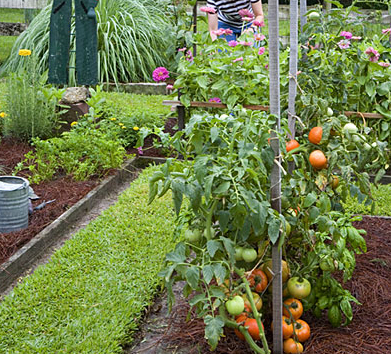
Fertilizer application
For maximum growth and yield of crops can be achieved not only through organic manures and can be improved better by the application of inorganic fertilizers. Top dressing with nitrogenous fertilizers improves plant growth and yield of vegetables. This can be done by applying urea or DAP or ammonium sulphate in small quantities. In general, 5-10 g of urea may be applied in moist soil once in a week or 10 days starting from 3 weeks after sowing or 2 weeks after transplanting. In general, 5 to 10 grammes of complex fertilizers (17:17:17 / 20:20:20) containing NPK mixture is applied in three stages as follows:
- 30 days after planting (i.e) on set of vegetative phase = 5 to 10 grammes/plant
- 60 days after planting (i.e) on set of flowering phase = 15 to 20 grammes/plant
- 90 days after planting (i.e) on set of fruiting phase = 15 to 20 grammes/plant
In addition to the above, vermicompost 100 grammes/plant should be applied at monthly intervals. Care must me taken that vermicompost should not mix with any inorganic fertilizers. Hence the application of vermicompost and inorganic fertilizers should not be practiced simultaneously. Heavy doses of fertilizer are very harmful. Immediately after fertilizer application, the plant should be watered.
Weed Control : Hand hoeing and weeding helps in aeration in the root zone and help the plant grow healthy. Weeds should be removed gently in leafy vegetable crops like amaranthus, fenugreek, spinach, coriander etc.
Pest and disease management
- Pick and destroy the larvae found on fruits and vegetables and then spray Neem oil @ 4 ml/liter of water + sticking agent 2 ml/liter of water or kadi soap or
- Neem Seed Kernel Extract @ 3 % + sticking agent 2 ml/liter of water or kadi soap
- Avoid spraying of toxic chemicals.
Based on the growth pattern and climatic factors vegetables are attacked by various pests and diseases. Aphids and jassids are small sucking insects, injuring the plants especially in early stages of their growth. Spraying of Dimethoate @ 2ml / liter of water + Neem oil @ 4 ml/liter of water + sticking agent 2 ml/liter of water or kadi soap controls these insects. Fruit fly and fruit borer are serious pests of some vegetable crops. They damage young fruits and make them unfit for consumption.
The affected fruits should be plucked and destroyed. The plants should be sprayed once or twice with insecticides. After spraying, fruits should not be harvested for 7-10 days for consumption. Fungal diseases (damping off and wilt) and viral disease affect the plants particularly during the rainy season. Fungal diseases can be controlled by drenching the soil with ‘Captaf’ solution @ 2g / lit of water. Virus affected plants should be removed and destroyed.
Harvesting
Vegetables harvested at the peak of maturity and used promptly, are always superior in nutritional content, freshness, flavour and appearance. Leafy vegetables should be picked up frequently when tender. Root vegetables should be pulled out while tender otherwise they become pithy. Tomato is picked at ripe stage, brinjal and okra are picked after they attains full size but still tender.
Rare vegetables like leek, fennel, and soya are not available in market always. Thus these can be advantageously raised in containers. Curry leaf, Checkurmanis and gooseberry can also be grown in medium to big sized containers in a roof garden.
Post harvest operations
Digging of soil: As soon as the season is over i.e., after the final harvesting of vegetables, remove the plant from the pot / polythene cover and dump the soil in open place and break the clods.
Application of organic manures: After 15 days, add organic manures and mix the soil thoroughly and refill the pots or polythene covers.
Choose alternate crops: In order to maintain proper recycling of nutrients, crop rotation can be adopted. Hence choose alternate crops for the next season.
Ornamental plants suited for roof garden
Ornamental trees
Bauhinia purpurea, Plumeria alba and Callistemon lanceolatus
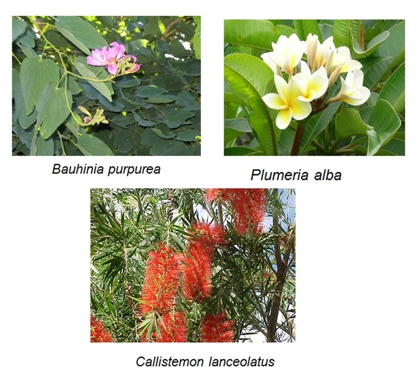
Shrubs
Acalypha hispida, Allamanda grandiflora, Barleria cristata, Bauhinia tomentosa, Clerodendron inerme, Dombeya spectabilis, Duranta plumieri, Hamelia patens, Hibiscus rosasinensis, Mussaenda erthyrophylla, Nerium oleander, Poinsettia pulcherrima, Tecoma stans, Thevetia nereifolia, Codioeum sp, Eranthemium elegans and Pisonia alba


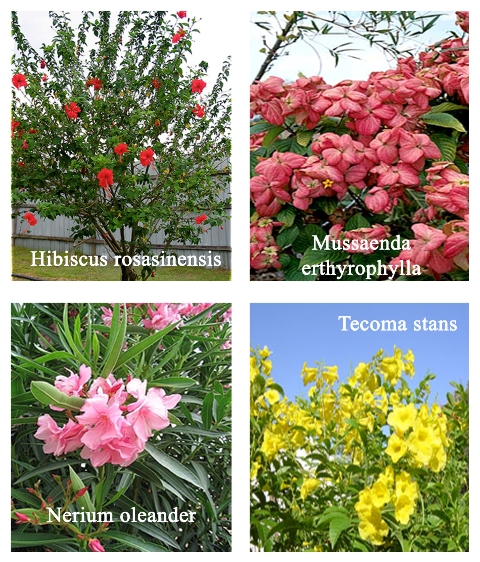

Climbers: Allamanda cathartica, Asparagus densiflorus, Bougainvillea sp, Clitorea ternatea, Ipomoea palmate, Quisqualis indica
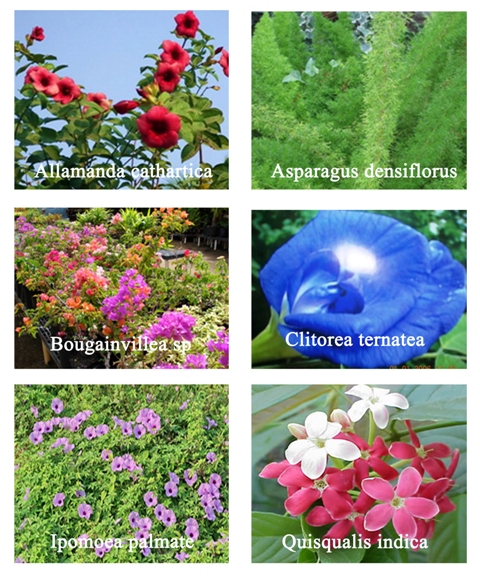
Flowers: Impatiens balsamina, Celosia sp, Chrysanthemum sp, Cosmos bipinnatus, Gomphrena globosa, Tagetus erecta, Petunia hybrida, Portulaca grandiflora, Salvia splendens, Solidago Canadensis, Vinca rosea and Zinnia elegans


Lawn grass
- Grassy area
- Charming effect
- Breaks the monotony and brings the integrity of garden components
- Cushiony layer for players who are engaged in sport activities
- Checks the pollution
- Increase the monetary value of land
Types of lawn grasses
S. No. |
Botanical name |
Common name |
Texture |
Situation |
1. |
Cynodon dactylon |
Hariyali (or) Arugu (or) Doob grass |
Medium |
Suitable for open sunny location; drought tolerant |
2. |
Stenotaphrum secundatum |
St. Augustine grass |
Coarse |
Suitable for shady situation with frequent irrigations |
3. |
Zoysia japonica |
Japan grass |
Coarse |
Can grow well in poor sandy soil and suited for open sunny situation |
4. |
Paspalum vaginatum |
Paspalum grass /
Sea Shore Paspalum |
Medium |
Suitable for open sunny situation, highly drought tolerant |
Selection of site
- Open sunny places and preferably with little quantity of shade.
- Site should have ample quantity of water for irrigation.
- Free from hazards like grazing and use of pathways
- Site should not be under the tree canopy as the litter affects the quality of turf grass
- Poorly drained soils should be avoided.
- Soil and water should be medium to good quality.
Primary operations
Site clearing
(Uprooting of tree roots, stumps and concretes)

Back filling with soil mix
(Red soil: Sand: Compost – 2:1:1 ratio)

Laying of irrigation lines – main and laterals

Soil compaction
Final leveling with gentle slope for drainage
(Red soil: Sand: Compost – 2:1:1 ratio)
Methods of lawn making
- Seeding
- Dibbling / Sprigging
- Sodding / Turfing
Seeding
- 30 – 32 kg of seed is required for planting one hectare area (10,000 ha)
- Seeds normally take 25 – 30 days for germination
- Seeds are mixed with double the quantity of fine textured soil preferably of sand and sown uniformly on a windless day

Care
- Till establishment, flood watering and hose watering is avoided
- Mowing should be done after 50 – 60 days of sowing
Disadvantages
- Poor establishment when compared to other methods.
- The availability of good quality seeds.
Sod / Turfing
Selecting turf pieces
- Should be free from sod worms
- Free from nutritional deficiency
- Free from weed population
- Sod should be properly cut without any deformations
- Height of the grass should be optimum
- Free from other pest and diseases
Precautions
- Mowing should be done 20 – 25 days after planting or depending upon the complete establishment.
- The uneven surfaces and gaps can be fitted with turf plugs with sand.
- Turfing should not be practiced in winter seasons as it exhibits yellowing due to low temperature and low light intensity.
Advantages |
|
- Quick and instant establishment
|
|
|
|
- Best suited for exhibitions, sports grounds
|
|
Disadvantages |
|
- Poor establishment during winter season
|
Dibbling / Sprigging

- Turf grass are separated along with their root portion is dibbled at 10 – 15 cm distances
- Sprouting at 25 – 30 days
- Complete coverage may take around 3 – 4 months after planting
Precautions
- Mowing should be done 30 – 35 days planting.
- Mowing should be done at one-third level without affecting the foliage growth.
- Traffic movement should be avoided till the establishment.
- Light irrigation followed by rolling improves the turf appearance.
Advantages: Cheapest method
Disadvantages
- Slow establishment
- Cost of planting is higher, when compared to other method of establishment.
Quarterly fertilizer input ratio for turf grass
Situation |
Urea |
Superphosphate |
Murite of potash |
(g/m2) |
Low Maintenance
(Residential turfs) |
100 |
75 |
75 |
High Maintenance
(e.g. Turf in public gardens) |
200 |
100 |
150 |
Intensive Maintenance
(e.g. Sports fields) |
300 |
150 |
150 |
-
Applied in two split doses (at 6 months intervals i.e., onset of summer and onset of winter season)
-
Irrigate the lawn after fertilizer applicati
Maintenance of lawn grass
a)Mowing
b)Weed management
- Controlled by spot application / drenching with Glyphosate @ 5 ml/litre of water + Ammonium sulphate @ 10 g/litre of water
c)Nutrient management
- Fertilizers are applied in split doses @ 40 days interval
- Irrigation is given immediately after fertilizer application
d).Pest and disease management
- Spray Dimethoate/Acephate @ 2 ml/liter + Dithane M-45 @ 2 g/liter
-
Sprayed on rainless day
Do’s and Don’ts
Do’s
- Place the pots in available space, accordingly to sunshine requirement.
- Always check the drainage in the pots.
- Leave 1” space in the pot at the rim, to facilitate irrigation.
- Always sow the nursery in separate pots or protrays.
- Use deep pots for plants with deeper roots (perennials) and shallow for shallow rooted plants (annuals).
- Keep large and heavy pots in strong part of the building.
- Irrigate as and when required, after checking the moisture regime of the pot.
- Always keep the pots and plants weed free, disease and pest free.
- Place pots away from each other to facilitate air circulation.
- Avoid spraying of toxic chemicals.
Don’ts
- Don’t overwater the pots.
- Don’t let the drainage hole clog or don’t block the drainage hole.
- Don’t place too many pots together.
- Don’t place heavy pots in apartments if the building is not constructed to bear the weight since damp soil is much heavier than dry soil.
- Don not grow perennial plants (fruit crops like mango, sapota and guava) at roof top, since the heavy feeder roots may penetrate / damage the roof top.
Other considerations
- In the safer point of view, the roof top has to be painted with anti damp or damp proof paint to avoid seeping of water to roof of the house and staining the floor and roof.
- The garden work can be shared by all the members of the family. The strenuous work like lifting the pots, pot filling and weeding can be assigned to the youngsters, harvesting can be done by old people and children of the family. Women can participate in weeding and irrigation.
- It is good idea to replenish the media with FYM periodically, say after every season or harvest so that the nutrient status of the soil is maintained. After one year or 3 seasons the media has to be changed using fresh soil and sand.
- Large concrete pots of 2 ½ -3’ or waste / damaged plastic drums can be used to grow papaya and banana.
- When the inmates are out of station for 7-10 days the most important consideration is irrigation for which the following can be done.
- The drainage plates can be filled with water to maintain the moisture level.
- Some mulch can be used on top of the pot soil, like a plastic sheet or straw / moss mulch.
- For greens, since frequent watering is important, several layers of newspaper can be tied to the body of the pot and the newspapers should be completely drenched with water.
- To raise seedling like tomato or brinjal, “Protrays” which are trays with shallow depth (2-2.5”) should be used. The seed can be sown in small quantity also without wastage.
A pot of 1m depth and convenient length width may be used for composting plant residue / kitchen waste. Vegetable wastes like leaf waste, onion peels, waste vegetables, pulp wastes, tea wastes, chopped pieces of cauliflower / cabbage can be effectively decomposed in the pits / plastic barrels. The vegetable wastes are dumped and a layer of soil (1’’ thickness) may be added at the top for efficient and quick decomposition. The rate of decomposition can be enhanced by sprinkling water daily.
The kitchen waste can be dumped daily or as per the availability. Few earthworms may also be added for faster decompostion. The compost is ready for use within two and half months to three months. The well composed material will be dark brown in colour. The partially decomposed / undecomposed materials and earthworms were again dumped back along with the earthworms. Avoid non vegetarian items as it may create a fowl smell. The best location for compost preparation is shady to semi-shady locations.
Physical and psychic utility
Owing to the seat bound office jobs, there is hardly and physical activity in our lives. This lack of exercise has lead to a number of health hazards. Roof garden system of vegetable cultivation provides an alternative to people living in all kinds of dwellings – individual houses, flats, or apartments. A family can tend the garden as a team. This can be a healthy family time to interact and talk, while doing a useful activity from the point of health and economy. This physical exercise helps us to forget the tensions of office and our minds can freshen up.
With the passage of time, the traditional joint family system is breaking up in India and most of the families are fragmenting into nuclear families on account of struggle for money and job strains. In families where grand parents are a part, the older generation feels left out. With a roof garden at home, even the old people can participate and feel one of the group and work rather than feeling left out. Thus having a garden is not only a physical or monitory need but a psychological too.
Source
1.http://www.cityfarmer.info/2009/04/28/chef-at-vancouvers-fairmont-waterfront-hotel-harvests-apples
2.http://www.thehindu.com/life-and-style/homes-and-gardens/article2438.ece
3.http://civileats.com/category/grow-your-own/roof-garden-rookies
4.http://images.businessweek.com/ss/09/05/0514_green_china_awardees/15.htm
5.http://www.cityfarmer.info/2011/03/22/urban-agriculture-in-bangladesh/
6.http://www.cityfarmer.org/slack.html
7.http://www.tnau.ac.in/chennai/chennai.html
8.http://www.cityfarmer.info/wp-content/uploads/2011/06/roofny67.jpg
9.http://www.cityfarmer.info/wp-content/uploads/2011/06/tomat45.jpg
10.http://www.technologyforthepoor.com/UrbanAgriculture/Garden.htm
11.http://www.thelovelyplants.com/preparing-for-the-summer/
12.http://architectsforlife.com/wp-content/uploads/2010/12/Pretty-herb- garden1-500x500.jpg
13.http://www.flickr.com/photos/pederhanson/3272456124/sizes/m/in/phot
14.http://thegrowingconnection.blogspot.com/2009_08_01_archive.html&usg=__k9O6rvRaLnruhlaXDa0Ag7s7sb0=&h=240&w=320&sz
15.http://www.superstock.co.uk/stock-photos-images/1566-617888
16.http://ubeautypotsandplants.blogspot.com/p/coconut-fibre-pots.html
17http://ca.all.biz/img/ca/catalog/25742.jpeg
18.http://farmerpraba.blogspot.com/2009_07_01_archive.html&usg
19.http://www.eurekatomatoes.com/assets/images/stake-tomatoes-l.jpg
20.http://tree-species.blogspot.com/2007/11/purple-orchid-tree-bauhinia-purpurea.html
21.http://australian-insects.com/lepidoptera/plants/apoc/plumeria-alba.jpg 22.http://mgonline.com/media/Images/b/bottlebrush01.jpg
23.http://mariposanursery.com/images/plants/shrubs/acalypha%20hispida.jpg
24.http://www.oramsnurseries.com.au/allamanda_sunee.jpg
25.http://pics.davesgarden.com/pics/2007/01/27/onalee/3c5003.jpg
26.http://toptropicals.com/pics/garden/trees/4423.jpg
27.http://www.google.co.in/search?tbm=isch&hl=en&source=hp&biw=&bih=&q=Clerodendron+inerme&btnG=Search+Images&gbv=1
28.http://media.growsonyou.com/photos/photo/image/47498/main/Mission_Bay_Pics_10_15_08_064.jpg
29.http://almostedenplants.com/shopping/images/full/Duranta%20repens%20blue%20form.jpg
30.http://www.hawaiiantropicalplants.com/PHOTOS/Hamelia_patens.jpg
31.http://farm4.static.flickr.com/3581/3439960287_928222b8e0.jpg
32.http://www.rarefloweringtrees.com/g2/main.php?g2_view=core.DownloadItem&g2_itemId=1013&g2_serialNumber=3
33.http://www.alphabeticallistofflowers.org/uploads/allimg/100413/15492BX2-1.jpg
34.http://ih2.redbubble.net/work.417351.6.flat,550x550,075,f.mexican-flame-leaf-poinsettia-pulcherrima.jpg
35.http://www.google.co.in/search?tbm=isch&hl=en&source=hp&btnG=Search+Images&gbv=1&q=Tecoma%20stans,
36.http://www.photomazza.com/IMG/jpg_Thevetia_peruviana.jpg
37.http://lh4.ggpht.com/_JNM3pjWIzMs/RiKD0YgMKJI/AAAAAAAABe8/nblpHg7jOGU/DSCN0483.JPG
38.http://3.bp.blogspot.com/_6ANko4sjweM/SXR0h0utPLI/AAAAAAAAGfA/
39.Fm2pl3uMG1Y/s400/Eranthemum+pulchellum.JPG39http://toptropicals.com/pics/garden/05/5/5226.jpg40.http://www.google.co.in/imgres?imgurl=http://www.floraskolkata.com/images/allamanda_purple1.jpg
41.http://www.nathankramer.com/garden/plants/ferns/Asparagus_densiflorus.jpg
42.http://www.hear.org/starr/images/images/plants/full/starr-060928-0425.jpg
43.http://2.bp.blogspot.com/_nz0Jt1GtEmc/SMoMpAGdsPI/AAAAAAAAAe4/jP-MkFSBtN4/s400/Clitorea+ternatea01.JPG
44.http://farm5.static.flickr.com/4142/4920792391_eae5684e7d.jpg
45.http://www.magnoliagardensnursery.com/productdescrip/pictures300/Quisqualis300.jpg
46.http://www.zone10.com/images/impatiens-balsamina.jpg
47.http://www.sciencephoto.com/image/43321/530wm/B8044172-Celosia_plants_Celosia_sp._-SPL.jpg
48.http://farm4.static.flickr.com/3541/3793430490_73858d29a4.jpg
49.http://www.bbc.co.uk/gardening/plants/plant_finder/images/large_db_pics/large/cosmos_bipinnatus_sonata_series.jpg
50.http://farm4.static.flickr.com/3227/2724533249_b18bf17ff9.jpg
51.http://www.backyardgardener.com/tmimages08/280/7/7089.jpg
52.http://oregonstate.edu/dept/ldplants/images/petunia-h1.jpg
53.http://www.landscapedia.info/images/plant_images/Portulaca_grandiflora__Moss_Rose.jpg
54.http://www.sagewisdom.org/splendens.jpg
55.http://www.laspilitas.com/s/images/plants/1203/Solidago_canadensis_elongata.jpg
56.http://1.imimg.com/data/G/Q/MY-282770/vinca-rosea_250x250.jpeg
57.http://www.lonniesbulkseeds.com/Annuals/Zinniacaliforniagiant.c.jpg |
|



 .
. 



















































